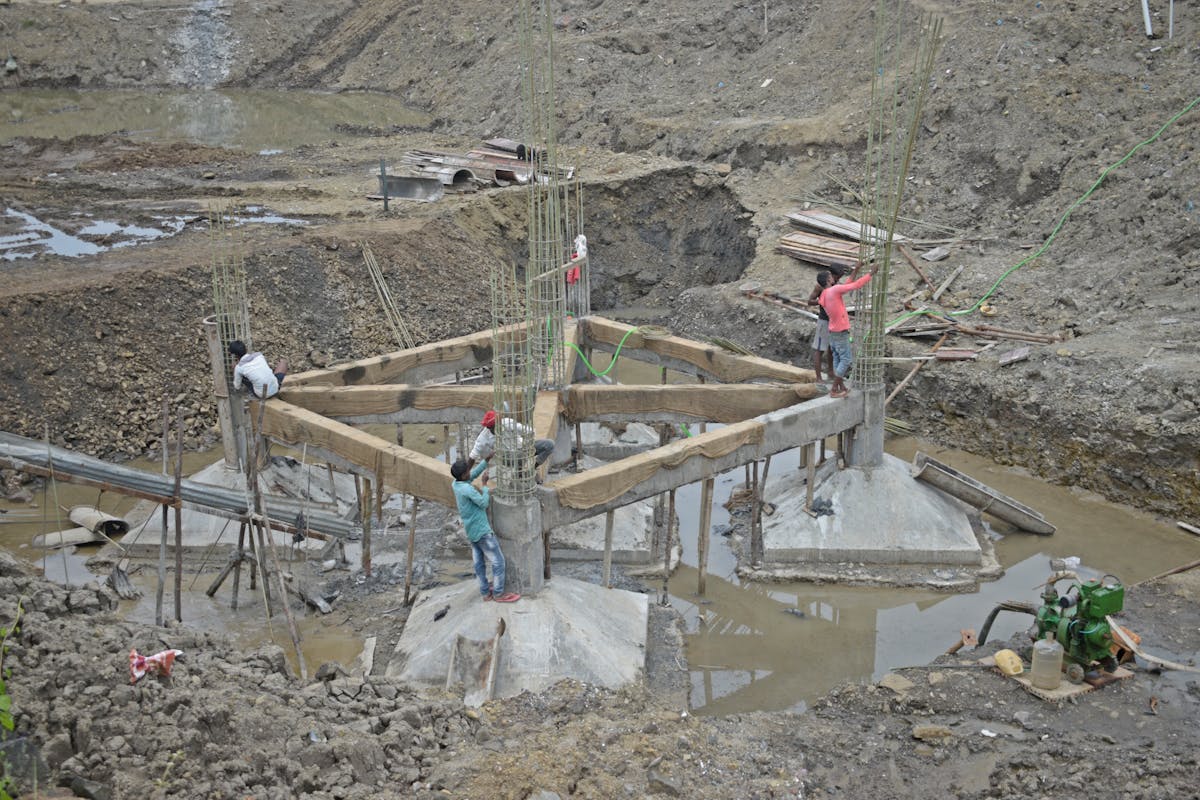Structural concrete failures often ignite complex legal battles, given their dire consequences on human life and economic stability. These failures raise questions about compliance with building codes and construction standards, thrusting engineers and architects into the spotlight. Investigations meticulously dissect design documents, construction practices, and material quality to uncover root causes. Determining liability is paramount in these analyses, setting essential precedents for future safety regulations. What revelations will these investigations bring?
The Rising Incidence of Structural Concrete Failures
The phenomenon of structural concrete failures has been progressively garnering attention due to its increasing frequency and the potential ramifications on safety and infrastructure integrity. Analyzing this trend reveals a complex interplay of factors, primarily revolving around construction quality and adherence to increased regulations. Investigations have pinpointed lapses in material standards, inadequate reinforcement, and poor workmanship as pivotal contributors. The industry’s response has been an intensified focus on regulatory frameworks, aiming to mitigate risks associated with substandard practices. However, the effectiveness of these regulations remains contingent on rigorous enforcement and compliance. The growing body of failure cases underscores the necessity for heightened diligence in construction protocols, emphasizing the importance of quality assurance and the meticulous application of building codes to avert future structural deficiencies.
High-Profile Disasters and Their Immediate Impact
Examining incidents of structural concrete failures brings to light several high-profile disasters that have had immediate and profound impacts on public safety and infrastructure integrity. Notable high-profile incidents, such as the collapse of bridges and buildings, underscore the immediate consequences of compromised structural integrity. These failures often result in catastrophic outcomes, including loss of life, significant economic disruption, and erosion of public trust in engineering standards. The immediate aftermath typically involves emergency response efforts, extensive investigations, and temporary infrastructure adjustments. Moreover, these disasters prompt rigorous scrutiny of existing construction protocols and regulatory measures. The ripple effects extend beyond the immediate geographic locale, influencing global engineering practices and legislative frameworks to prevent recurrence and guarantee the resilience of future infrastructure projects.
The Role of Engineers and Architects in Ensuring Safety
Engineers and architects play a critical role in ensuring the safety of concrete structures through strict adherence to design standards and thorough risk assessment protocols. By meticulously following established codes and guidelines, they not only enhance structural reliability but also mitigate potential hazards. Systematic evaluation of environmental and operational risks further fortifies these efforts, ensuring that potential vulnerabilities are identified and addressed efficiently.
Design Standards Compliance
When guaranteeing the structural integrity of concrete constructions, compliance with design standards is paramount. Engineers and architects play a critical role in adhering to design regulations that govern material specifications, load calculations, and construction methodologies. Meticulous attention to detail during the design phase guarantees that all structural elements meet or exceed established benchmarks. Compliance audits are conducted to verify that construction practices align with approved plans and regulatory requirements. These audits provide a layer of scrutiny, minimizing the risk of structural failures. The professionals involved must maintain a thorough understanding of evolving standards and integrate them into their workflow. Their commitment to design standards compliance not only safeguards public safety but also mitigates potential legal ramifications arising from structural inadequacies.
Risk Assessment Protocols
Guaranteeing the structural integrity of concrete constructions extends beyond mere compliance with design standards; it necessitates an all-encompassing approach to risk assessment protocols. Engineers and architects play a pivotal role in conducting thorough risk evaluations and hazard identification to preemptively address potential vulnerabilities. By systematically analyzing design schematics and site conditions, they identify latent risks that could compromise structural safety. This detailed assessment involves considering environmental factors, material performance, and construction methodologies. Advanced simulation tools and empirical data further aid in predicting failures, enabling proactive mitigation strategies. The meticulous documentation and communication of identified hazards are essential for developing robust safety plans. Ultimately, their expertise guarantees that safety considerations are not only theoretical but integrated into practical, executable plans.
Legal Framework Governing Construction Standards
The legal framework governing construction standards is pivotal in ensuring building code compliance, which serves as the benchmark for safe structural design and execution. Liability and negligence are critical components in this framework, where failure to adhere to established codes can result in legal consequences for professionals and firms involved. Analyzing these legal dimensions provides insight into the mechanisms that hold parties accountable and promote adherence to safety standards in the construction industry.
Building Code Compliance
Compliance with building codes forms a fundamental pillar in the construction industry, dictating the standards that guarantee structural integrity and public safety. Building regulations are meticulously crafted, encompassing specifications for materials, design, and construction processes. These codes serve as a benchmark for quality assurance, ensuring that structures can withstand environmental stresses and usage demands. Compliance audits play a vital role in this framework, acting as systematic evaluations to verify adherence to prescribed standards. These audits involve rigorous inspections and documentation assessments to identify deviations or deficiencies. When building code compliance is overlooked, the risk of structural failures increases, posing potential hazards to occupants and escalating legal repercussions. Therefore, adherence to these regulations is paramount for maintaining safety and reducing liability risks.
Liability and Negligence
When structural failures occur, the legal landscape surrounding liability and negligence becomes vitally important in evaluating responsibility and consequences. The determination of negligence claims hinges upon establishing a breach of duty in adherence to construction standards and codes. Liability issues emerge when such breaches result in structural inadequacies, potentially leading to catastrophic failures. Legal frameworks necessitate a rigorous examination of contractual obligations and professional duties of architects, engineers, and contractors. Adjudicating negligence claims involves evaluating whether the parties involved exercised reasonable care and skill. Liability issues are often compounded by complex interactions between multiple stakeholders, each potentially contributing to the failure. Detailed forensic investigations and expert testimonies are essential in deciphering these intricate legal challenges, thereby influencing the outcomes of major legal battles.

Investigative Processes in Determining Failure Causes
Initiating a thorough investigation into structural concrete failures involves a systematic and methodical approach to identify the root causes. The process commences with failure analysis, which entails a detailed examination of the concrete structure, aiming to pinpoint where and how the failure occurred. Investigative techniques include collecting physical evidence, analyzing design documents, and conducting material testing. Engineers meticulously assess load calculations, construction practices, and adherence to design specifications. Advanced tools like non-destructive testing and finite element analysis are employed to simulate structural conditions and assess potential weaknesses. Data gathered is evaluated against industry standards to determine discrepancies. This analytical process is critical in understanding the failure’s origin, offering insights to prevent recurrence and guarantee future structural integrity.
Liability: Who Bears the Responsibility?
How is responsibility determined when structural concrete failures occur? Establishing liability involves examining contractual obligations, construction practices, and compliance with engineering standards. Accountability measures are scrutinized, focusing on whether designers, contractors, or material suppliers adhered to or deviated from established protocols. Forensic analysis aids in pinpointing the cause, enabling a precise allocation of fault. Insurance coverage plays a pivotal role, as policies must be evaluated to determine the extent of financial protection afforded to involved parties. Legal frameworks guide the adjudication process, often resulting in complex litigation. Stakeholders may include architects, engineers, and construction firms, each potentially bearing partial responsibility. Ultimately, clarity in contracts and diligent adherence to building codes are critical in mitigating disputes over liability.
The Impact of Public Pressure and Media Coverage
Public pressure and media coverage profoundly influence the discourse surrounding structural concrete failures. Media influence shapes public perception by highlighting incidents, scrutinizing involved parties, and amplifying concerns about safety standards. Detailed reports and widespread coverage elevate such issues to national prominence, demanding accountability and expediting legal proceedings. This media-driven narrative can precipitate public outcry, prompting regulatory bodies to initiate investigations more rapidly. As a result, public perception often demands transparent communication from both corporations and government entities, exerting pressure on them to address safety lapses. Additionally, media outlets play a critical role in disseminating technical analyses and expert opinions, further informing the public. Therefore, the interplay between public pressure and media coverage considerably impacts legal, regulatory, and remedial actions following concrete structural failures.
Strategies for Risk Mitigation and Prevention
In light of the intensified scrutiny brought about by media coverage and public pressure, addressing structural concrete failures necessitates a thorough approach to risk mitigation and prevention. Proactive measures are essential, including rigorous design evaluations and regular maintenance schedules. Detailed inspections should identify potential vulnerabilities before they escalate. Implementing extensive training programs for engineers and construction personnel guarantees adherence to best practices and standards. These programs should cover material properties, load calculations, and construction techniques. Additionally, risk assessments must be conducted at each project phase, employing robust methodologies to foresee and mitigate potential issues. By integrating these strategies, stakeholders can reduce the likelihood of failures, thereby safeguarding public safety and minimizing the potential for legal disputes.
Technological Innovations Improving Structural Integrity
Why do emerging technologies hold the key to enhancing structural integrity in concrete constructions? The integration of smart materials and advanced structural monitoring systems offers substantial improvements in maintaining and extending the lifespan of concrete structures. Smart materials, such as self-healing concrete, utilize microcapsules filled with healing agents to repair minor cracks autonomously, thereby mitigating early-stage damage. Concurrently, structural monitoring technologies employ sensors and data analytics to provide real-time insights into the health of a building. These systems detect stress, strain, and other anomalies that may precede structural failures, allowing for timely interventions. Additionally, expert structural concrete solutions, including specialized foundation work and restoration techniques, play a crucial role in ensuring long-term durability. By leveraging these innovations, engineers can predict and prevent potential failures, ultimately enhancing safety, reducing maintenance costs, and extending the operational lifespan of concrete infrastructures.
Frequently Asked Questions
How Does Insurance Play a Role in Disaster Investigations?
Insurance plays a pivotal role in disaster investigations by guiding the claims process and addressing liability issues. It systematically evaluates damages, determines responsibility, and facilitates compensation, ensuring a thorough resolution through methodical assessment and precise legal compliance.
What Are Common Signs of Impending Structural Failures?
Common signs of impending structural failures include cracking concrete, uneven surfaces, rusted reinforcements, water intrusion, mold growth, and misaligned structures. These indicators require detailed analysis for timely mitigation and prevention of catastrophic outcomes.
How Do Cultural Factors Influence Construction Practices and Safety Standards?
Cultural perceptions greatly shape construction practices, impacting safety regulations adherence. Societal values prioritize different safety aspects, influencing regulatory rigor and enforcement. Consequently, safety standards vary, reflecting local cultural attitudes towards risk and construction industry professionalism.
Are There International Comparisons of Legal Battles Related to Structural Failures?
International comparisons of legal battles related to structural failures often involve analyzing legal frameworks and international standards. This approach highlights discrepancies in accountability, enforcement, and resolution mechanisms across different jurisdictions, emphasizing the global diversity in handling such cases.
How Do Economic Factors Affect Decisions in Construction Safety Practices?
Economic factors considerably impact construction safety practices through cost benefit analysis and budget constraints. Decisions often prioritize financial feasibility, potentially compromising safety standards when budget limitations outweigh perceived benefits, affecting the implementation of extensive safety measures.




